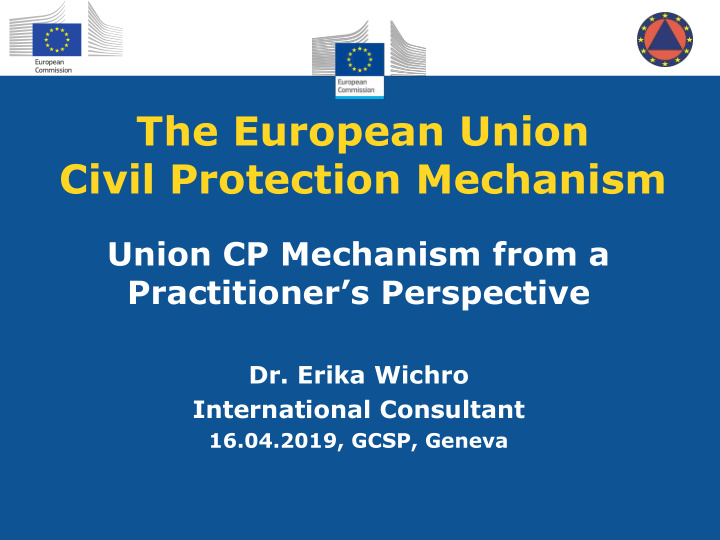



The European Union Civil Protection Mechanism Union CP Mechanism from a Practitioner’s Perspective Dr. Erika Wichro International Consultant 16.04.2019, GCSP, Geneva
Union Civil Protection Mechanism Content: 1. What is the EU Civil Protection Mechanism 2. Overall capacities w/+ focus on medical assets (EMC) 3. Strategies to further strenghtening the UCPM 4. Practitioner`s perspective 5. Conclusion
EU Civil Protection Mechanism • Covers prevention, preparedness and response • Commission + 28 MS + 6 participating states (Iceland, Norway, North Macedonia, Montenegro, Serbia, Turkey) • Response: facilitates and supports the provision of European CP assistance interventions in major disasters • Natural and man-made (technological, environ., terrorism, health, consular support) disasters inside/outside EU • Type of assistance: modules/specialized teams/other capacities/experts/in-kind assistance/ medical, etc.
The European Union Civil Protection Mechanism Union Civil Protection Mechanism (See: http://ec.europa.eu/echo/field-blogs/videos/european-emergency-response_en) EU Civil Protection - Coordination in Action (See: http://ec.europa.eu/echo/field-blogs/videos/eu-civil-protection-coordination-action_en) Inside the Emergency Response Coordination Centre ( See: https://www.youtube.com/watch?v=HTeNuIOVw6w&t=3s)
EUCPM over time: 2002 - 2018
Assistance What kind of assistance can be offered? 1. Civil Protection modules 2. Other Response capacities 3. In-kind assistance, spec. equipment 4. Expertise (for EUCPT or UNDAC) Formerly EERC – European Emergency Response Capacity Now called European Civil Protection Pool
Emergency Response Coordination Center (ERCC) support in general • 24/7 support (from 1 October 2013) • Analytical Support (analysis, plans, maps) • Providing Information (ECHO products, ERCC Portal) • Copernicus Satellite Mapping service • Emergency Toolbox (ALERT, Small scale Response, Epidemics, DREF) • Deployment support (+mobilization of VP assets) • Operational co-financing (up to 100 %)
European Civil Protection Pool With >100 additional registered Modules available
Modules in the European Civil Protection Pool • New European CP Pool – Module + other capacities + experts è rescEU • Currently 21 types of Modules (AMP1, AMP2, AMP3 in transition)
Modules Higly specialised emergency response teams (human and technical equipment) to respond more quickly to emergencies Main characteristics: • pre- defined = “standardi s ed” • registered in CECIS • work self-sufficiently • interoperable with other modules • trained and exercised
Modules + Emergency Medical Teams
Technical Assistance and Support Team Admin/office support Telecommunication support Accommodation support Subsistence support Mapping support
From Module to RescEU • 2007: 13 types of modules (pre-defined, self sufficient , interoperable,…) + TAST • 2014: • 4 types of modules (area flooding and forest fire fighting) added • EERC/VP modules, other capacities, experts • 2018: • EMC for acute health emergencies • EMT 1 (Stat., mob.), 2 + 3 added to modules • 2019: • EERC/VP renamend in European CP Pool • RescEU to cover gaps (aerial forest fire fighting)
Improving EU CPM through
Further strengthening EU CPM
European Medical Corps
Certification & Registration 1. Certification & Registration Process 2. 48 certifiers to support the process 3. Using MODEX as certifying framework 4. The number of assets in the European CP Pool is likely to increase . Direct impact: number of missions and need of additional exercises. 5. In 5 years, additional challenge: need of re-certifying some assets.
EU CP Training Programme – Capacity Building Needs-based additional trainings for technical experts with UN agencies (MOU) e.g. EMTCC with WHO, CCCM with IOM, Logistics Cluster training with WFP , and more.
Practitioner‘s perspective - FMT Coordination Support, UNDAC-UCP, UN Mission for Ebola Emergency Response, Accra, Ghana Nov-Dec 2014 UNDAC/UCP Mission Ghana & Sierra Leone Nov-Dec2014
Practitioner’s perspective: Communication-Coordination-Collaboration • Established FMT-Coordination Cell at UNMEER • Information Management – data base ERCC • Updated contact list (UNMEER, HQ, all 3 countries) • Several facilitated Medevacs • Established network among stakeholders • ….
EUCPM – in conclusion: Disaster Request for assistance stricken Acceptance / rejection of country/IO assistance offered Information update ERCC Offer of assistance Deployment of EU CP Teams Coordination and Co-financing of Transport Activation of the Mechanism
The Union Civil Protection Mechanism THANK YOU FOR YOUR ATTENTION! ANY QUESTIONS?
Recommend
More recommend